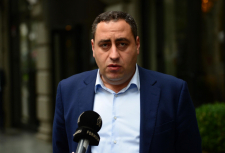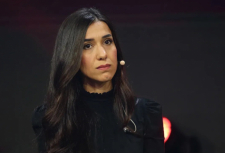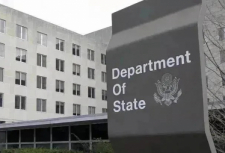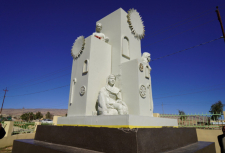The history of the Yazidi village of Khansour
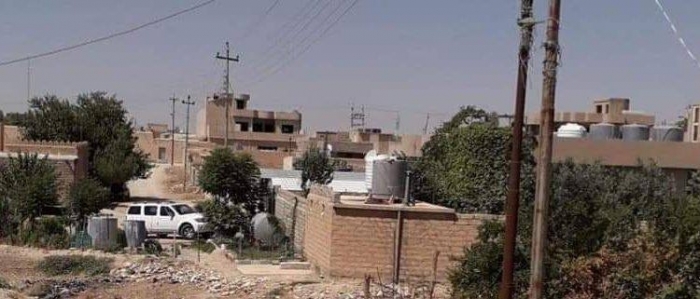
Researcher: Shukr Khadr Murad
Khansour is a village located in the northwest of Jabal Shankal, in the west of the north with a distance of 7 km and approximately 10 km near the Iraq-Syria border.
Khansour was named by this name in relation to one of the commercial boxes located in the north of the present village near Al-Sharkan neighborhood.
The Khan has its meanings for the rest of the commercial convoys coming from Iraq, Syria and Turkey in the past. This big Khan was in a strategic area painted in red clay, and it consists of several rooms for overnight traders, travelers, and travelers.
Its history
Its construction dates back to the era of the urban state in the year 240 AD.
It is the crossroads of trade coming from Hatra (the city of the sun) to Mount Shankal, passing through the Kabbani region, then Mamesi, then Khansur, then to Syria in the west, and to Anatolia, in the north.
Geographical nature
Khansour is located in a undulating region in which there are plain lands and many hills, such as Mahila, Reza Phara, Perv Hamo, Phangfang Pang and Pharagh Ghersz, and it has surface water and salt water ponds such as Mahila Ponds, and there is salt water near the main Khansour Valley and in Hamu Kulk region and others.
Its construction
As some of the clans erected their tents to graze their sheep in this area suitable for the pasture, including my uncle the late Hassan Ashouri built a house in it and over time, that is, at the beginning of 1942 they built houses built of stones, clay and milk in their hills after the agreement between clans such as The Sharkan clan at the time of the late Ahmad Jallu and the Aldukhayan from the (Hebo) family at the time of the late Osman Hassnuk, coming from the Qandil area to the west of Klee Kursa, known as Qandilah Awsamin.
With the passage of time, a large number of citizens were transferred from the aforementioned clans, and they built small villages for them, such as the Al-Dana Al-Dakhiyyah family, who are also from (Habbo).
Likewise, the Haji Ausu family moved to it after a dispute occurred between them and the Haskan clan in Sanuni in 1939 at the time of the late Shamu Hassan Haji Aso, and this led to the fighting between them in 1944, as well as the sons of the Kolkan clan from the Mahmoud family and Abdullah Ibrahim and the Tamo Assaf family who also lived in Khansour.
In 1961, the late Aswad Khadr Al-Khalaf installed a mill in Wadi Khansoor, near the village of Al Maru Musa, and was managed by the late Hajji Mujwa.
In 1964, the elementary school in Khansour was opened, as well as an artesian well, a police station and a veterinary department.
Its inhabitants depended on endemic agriculture, livestock and trade.
Khansour in 1975
When the Ba'athist government decided by its unjust decision during the time of President Ahmed Hassan al-Bakr to deport all the Yazidi villages from Mount Shankal and force them to live in the compounds in the summer of 1975, the villages mentioned below were deported to the village of Khansour and called the Nationalization Complex, which is.
1_ Al-Majbourieh is inhabited by the Al-Danadia clan.
2_ Viddi Talani Village is inhabited by the Bazawiya clan.
3_ Kandala village, inhabited by the Al-Jafriyah clan
4_ A village in Harfaa, inhabited by the Jifriyah clan
5_ Al-Jafriya village is inhabited by Al-Jafriyah clan
6_ The village of Qasrka Haliqi is inhabited by the Haliqa clan.
7_ Khayrafa Village (Condi Golo) inhabited by the Haliqa clan.
8_ The village of Kela Mandu is inhabited by the Al-Haliqa clan.
9_ Haliqi is inhabited by the Haliqa clan.
10_ Azzam village inhabited by the Al-Haliqa clan.
11_ The village of Shivarsh Garage is inhabited by the Haliqa clan.
12_ The village of Hijl, inhabited by the Al-Bazawiya Al-Adkhah clan.
13_ Karaki Hasari village inhabited by the Dada Al-Adkhah clan.
14_ Khadr Ahmed village inhabited by the Kusadiyya Al-Dakhiyyah.
15_ The village of Shamika is inhabited by the Al-Bazawiyyah community.
16_ The Lower Chair village is inhabited by the Al-Ato Al-Adkhah clan.
17_ The village of Qandila Anash is inhabited by the Al-Anch clan, Al-Dakhiyyah.
18_ The village of Mamesi is inhabited by the Kulkan Al-Adkhah clan.
19- The village of Ghazna Arnoki is inhabited by the Dalkhan clan, the Dukhan clan.
In 1976, primary schools were built in the complex with the construction of a health center, a police station, modern markets and a casino.
In 1978, the street was paved between the northern area (Sanouni) and the Nationalization Complex, in addition to the streets inside the complex.
In 1981 the electric current was connected and a project for drinking water was installed.
In 1985 a high school was built in the aforementioned complex, and the number of graduates of colleges and institutes in it increased by more than 400 graduates.
Tags:
The history of the Yazidi village of Khansour

Researcher: Shukr Khadr Murad
Khansour is a village located in the northwest of Jabal Shankal, in the west of the north with a distance of 7 km and approximately 10 km near the Iraq-Syria border.
Khansour was named by this name in relation to one of the commercial boxes located in the north of the present village near Al-Sharkan neighborhood.
The Khan has its meanings for the rest of the commercial convoys coming from Iraq, Syria and Turkey in the past. This big Khan was in a strategic area painted in red clay, and it consists of several rooms for overnight traders, travelers, and travelers.
Its history
Its construction dates back to the era of the urban state in the year 240 AD.
It is the crossroads of trade coming from Hatra (the city of the sun) to Mount Shankal, passing through the Kabbani region, then Mamesi, then Khansur, then to Syria in the west, and to Anatolia, in the north.
Geographical nature
Khansour is located in a undulating region in which there are plain lands and many hills, such as Mahila, Reza Phara, Perv Hamo, Phangfang Pang and Pharagh Ghersz, and it has surface water and salt water ponds such as Mahila Ponds, and there is salt water near the main Khansour Valley and in Hamu Kulk region and others.
Its construction
As some of the clans erected their tents to graze their sheep in this area suitable for the pasture, including my uncle the late Hassan Ashouri built a house in it and over time, that is, at the beginning of 1942 they built houses built of stones, clay and milk in their hills after the agreement between clans such as The Sharkan clan at the time of the late Ahmad Jallu and the Aldukhayan from the (Hebo) family at the time of the late Osman Hassnuk, coming from the Qandil area to the west of Klee Kursa, known as Qandilah Awsamin.
With the passage of time, a large number of citizens were transferred from the aforementioned clans, and they built small villages for them, such as the Al-Dana Al-Dakhiyyah family, who are also from (Habbo).
Likewise, the Haji Ausu family moved to it after a dispute occurred between them and the Haskan clan in Sanuni in 1939 at the time of the late Shamu Hassan Haji Aso, and this led to the fighting between them in 1944, as well as the sons of the Kolkan clan from the Mahmoud family and Abdullah Ibrahim and the Tamo Assaf family who also lived in Khansour.
In 1961, the late Aswad Khadr Al-Khalaf installed a mill in Wadi Khansoor, near the village of Al Maru Musa, and was managed by the late Hajji Mujwa.
In 1964, the elementary school in Khansour was opened, as well as an artesian well, a police station and a veterinary department.
Its inhabitants depended on endemic agriculture, livestock and trade.
Khansour in 1975
When the Ba'athist government decided by its unjust decision during the time of President Ahmed Hassan al-Bakr to deport all the Yazidi villages from Mount Shankal and force them to live in the compounds in the summer of 1975, the villages mentioned below were deported to the village of Khansour and called the Nationalization Complex, which is.
1_ Al-Majbourieh is inhabited by the Al-Danadia clan.
2_ Viddi Talani Village is inhabited by the Bazawiya clan.
3_ Kandala village, inhabited by the Al-Jafriyah clan
4_ A village in Harfaa, inhabited by the Jifriyah clan
5_ Al-Jafriya village is inhabited by Al-Jafriyah clan
6_ The village of Qasrka Haliqi is inhabited by the Haliqa clan.
7_ Khayrafa Village (Condi Golo) inhabited by the Haliqa clan.
8_ The village of Kela Mandu is inhabited by the Al-Haliqa clan.
9_ Haliqi is inhabited by the Haliqa clan.
10_ Azzam village inhabited by the Al-Haliqa clan.
11_ The village of Shivarsh Garage is inhabited by the Haliqa clan.
12_ The village of Hijl, inhabited by the Al-Bazawiya Al-Adkhah clan.
13_ Karaki Hasari village inhabited by the Dada Al-Adkhah clan.
14_ Khadr Ahmed village inhabited by the Kusadiyya Al-Dakhiyyah.
15_ The village of Shamika is inhabited by the Al-Bazawiyyah community.
16_ The Lower Chair village is inhabited by the Al-Ato Al-Adkhah clan.
17_ The village of Qandila Anash is inhabited by the Al-Anch clan, Al-Dakhiyyah.
18_ The village of Mamesi is inhabited by the Kulkan Al-Adkhah clan.
19- The village of Ghazna Arnoki is inhabited by the Dalkhan clan, the Dukhan clan.
In 1976, primary schools were built in the complex with the construction of a health center, a police station, modern markets and a casino.
In 1978, the street was paved between the northern area (Sanouni) and the Nationalization Complex, in addition to the streets inside the complex.
In 1981 the electric current was connected and a project for drinking water was installed.
In 1985 a high school was built in the aforementioned complex, and the number of graduates of colleges and institutes in it increased by more than 400 graduates.
Tags:

